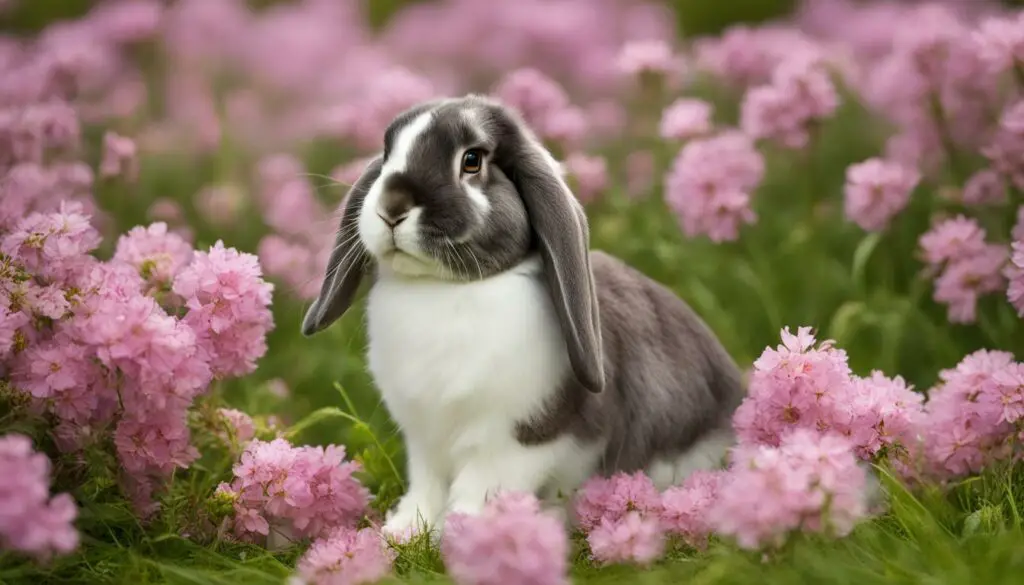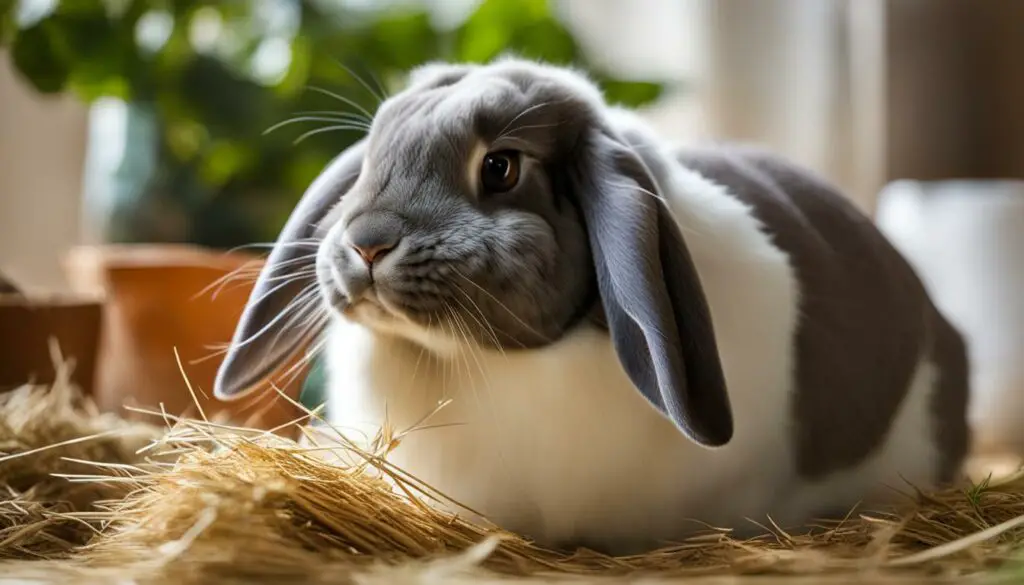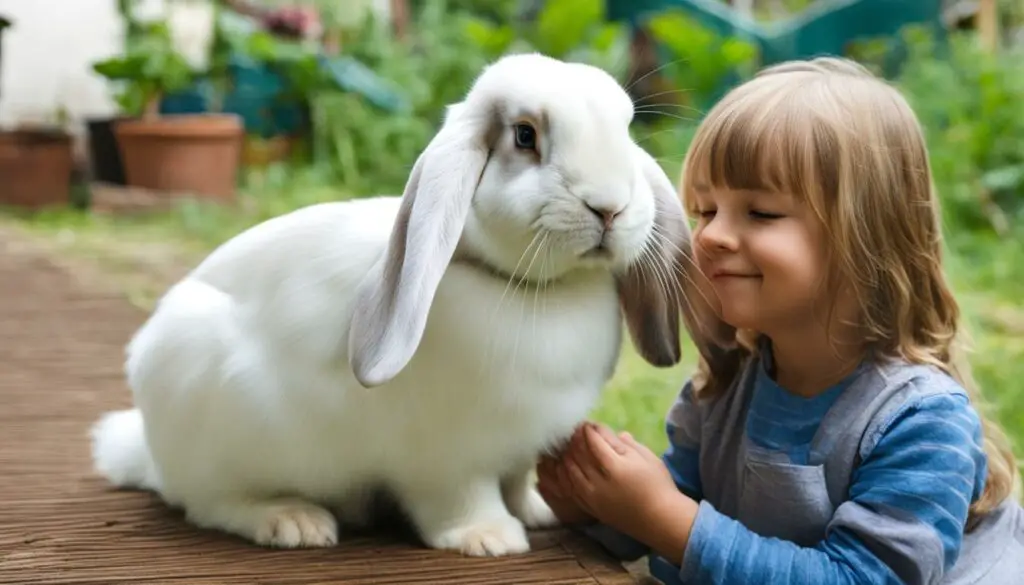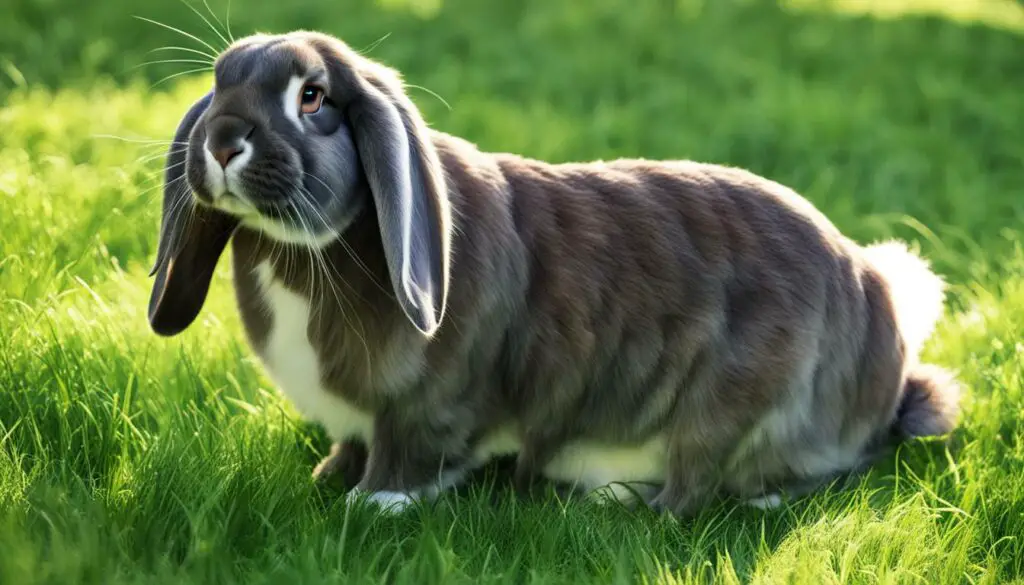Are you considering adding a furry friend to your family? Look no further than the full grown French Lop! These lop-eared bunnies are not only adorable but also make great companions. In this ultimate guide, I’ll introduce you to the wonderful world of French Lop rabbits and everything you need to know about caring for them.
Key Takeaways:
- The French Lop is a lop-eared bunny known for its large size.
- They are friendly, cuddly, and make great family pets.
- The breed is recognized by both the American Rabbit Breeders Association and the British Rabbit Council.
- Their dense and soft coat comes in a variety of colors.
- French Lops have a friendly and docile temperament, and their lifespan is typically between 5 to 7 years.
History of the French Lop
The French Lop breed has a fascinating history that dates back to the 1850s. It was originally developed in France by crossing an English Lop with a French Butterfly rabbit. Some sources even suggest that there may have been a cross with a Flemish Giant rabbit as well. Initially bred as a meat rabbit, the French Lop quickly gained popularity in neighboring countries like Germany, Netherlands, and Belgium.
In 1933, the French Lop was introduced to the United Kingdom and started making waves in the rabbit breeding community. However, it wasn’t until 1965 that the breed gained significant recognition when it was first exhibited. Surprisingly, the French Lop didn’t arrive in the United States until the early 1970s, but it has since become a beloved breed among rabbit enthusiasts.
Throughout its history, the French Lop has come a long way, transitioning from a meat rabbit to a popular pet and show animal. Its unique lineage and distinct characteristics make it a breed worth celebrating and learning about.

Table: French Lop Breed Origins
| Year | Event |
|---|---|
| 1850s | French Lop breed developed in France |
| 1933 | Introduced to the United Kingdom |
| 1965 | First exhibited, gaining recognition |
| 1970s | Arrived in the United States |
The history of the French Lop is a testament to the breed’s resilience and adaptability. From its humble beginnings as a meat rabbit, it has evolved into a cherished companion for individuals and families worldwide. Whether you’re a rabbit enthusiast or simply curious about the breed, understanding its fascinating history adds depth to the experience of owning a French Lop.
Characteristics of the French Lop
The French Lop is a breed of rabbit known for its impressive size and distinctive lop ears. They typically weigh between 10 and 15 lbs, making them one of the largest rabbit breeds. With a commercial body type, they have a thick and sturdy build. Their lop ears hang between 5 and 8 inches long, adding to their unique appearance.
This breed has a friendly and docile temperament, which makes them great companions for families. They quickly bond with their owners and enjoy being cuddled and petted. French Lops are not particularly destructive, but they should be provided with toys and activities to prevent boredom.
French Lops have a dense and soft coat that is short to medium in length. They come in a variety of colors, including white, brown, blue, black, and more. Their coat requires regular grooming to keep it clean and healthy.
Size Comparison: French Lop vs. Other Rabbit Breeds
When comparing the French Lop to other rabbit breeds, their size stands out. Let’s take a look at a table comparing the French Lop’s weight to other popular rabbit breeds:
| Rabbit Breed | Adult Weight |
|---|---|
| French Lop | 10-15 lbs |
| Holland Lop | 2-4 lbs |
| Dutch Rabbit | 4-5.5 lbs |
| Netherland Dwarf | 1-2.5 lbs |
As you can see, the French Lop is significantly larger than other rabbit breeds, making them a striking addition to any family or rabbit enthusiast’s home.
Lifespan and Health of the French Lop
The French Lop has a lifespan ranging from 5 to 7 years. While this may be shorter compared to some other rabbit breeds, it is important to note that the lifespan of any individual rabbit can vary based on factors such as genetics, diet, exercise, and overall care. By providing proper nutrition, regular veterinary check-ups, and a safe and enriched environment, you can help ensure that your French Lop lives a happy and healthy life.
Like all rabbits, French Lops are susceptible to certain health issues. It is essential to be aware of these potential problems and take appropriate measures to prevent and address them. Some common health issues that may affect French Lops include:
- Malocclusion: This is a dental condition characterized by misalignment of the teeth, which can lead to difficulty eating and overall discomfort. Regular dental check-ups by a veterinarian are crucial to ensure proper dental health for your French Lop.
- GI stasis: This is a condition where the digestive system slows down or stops, leading to a lack of appetite, bloating, and discomfort. A high-fiber diet, consisting mainly of hay, can help prevent GI stasis.
- Ear mites: These tiny parasites can infest the ears of rabbits, causing itching, irritation, and potential infections. If you notice any signs of ear mites, it is important to seek veterinary treatment promptly.
- Woolblock: French Lops have dense fur, making them prone to woolblock, a condition where ingested hair accumulates in the digestive system, causing blockages. Regular grooming and providing appropriate fiber-rich diets can help prevent woolblock.
It is crucial to monitor the health of your French Lop and seek veterinary care if you notice any concerning symptoms or changes in behavior. Regular veterinary check-ups can help detect and address any potential health issues before they become serious. By providing your French Lop with a loving and attentive environment, you can help ensure they live a happy and healthy life.
| Health Issue | Prevention | Treatment |
|---|---|---|
| Malocclusion | Regular dental check-ups | Professional dental treatment |
| GI stasis | High-fiber diet, regular exercise | Veterinary treatment, fluid therapy |
| Ear mites | Regular ear cleaning | Veterinary treatment, ear medication |
| Woolblock | Regular grooming, fiber-rich diet | Veterinary treatment, hairball remedies |
Remember, providing a healthy and enriching environment for your French Lop is key to their overall well-being. Along with regular veterinary care, a balanced diet, exercise, and mental stimulation can help ensure your furry friend leads a happy and fulfilling life.
Daily Life of a French Lop
When it comes to the daily life of a French Lop, there are a few key aspects to consider. First and foremost, their care and grooming routine play a crucial role in maintaining their overall health and well-being. French Lops have a short to medium length coat, which requires regular grooming to prevent matting and keep their fur in optimal condition. This involves brushing their fur gently using a soft brush or comb, paying extra attention to areas such as the ears and hindquarters. It’s also important to trim their nails regularly to prevent them from becoming overgrown.
Exercise is another essential element of a French Lop’s daily routine. These rabbits have a large and energetic personality, so ensuring they have enough space to exercise is vital. Providing them with a spacious enclosure or allowing them supervised free-range time for at least three hours a day will help keep them physically and mentally stimulated. French Lops enjoy exploring their environment and can be quite playful, so providing them with toys and tunnels will offer additional mental enrichment.
In terms of their care, feeding a balanced and nutritious diet is crucial for the overall health of a French Lop. Their diet should consist of hay, which should make up at least 70% of their daily food intake, along with high-quality rabbit pellets and fresh vegetables. It’s essential to provide them with fresh water at all times and monitor their food intake to prevent obesity, as French Lops can be prone to weight gain. Additionally, ensuring they have a clean and suitable living environment, with regular cage cleaning and fresh bedding, is essential for their comfort and well-being.
Overall, the daily life of a French Lop revolves around their care, grooming, exercise, and diet. By providing them with the necessary attention and meeting their specific needs, they can thrive in a loving and nurturing environment.

Grooming Routine for a French Lop:
- Brush their fur gently with a soft brush or comb to prevent matting.
- Pay special attention to areas like the ears and hindquarters.
- Trim their nails regularly to prevent them from becoming overgrown.
Exercise and Playtime:
- Provide them with a spacious enclosure or supervised free-range time for at least three hours a day.
- Offer toys and tunnels to keep them mentally stimulated and engaged.
Diet and Nutrition:
- Feed them a balanced diet consisting of hay, high-quality rabbit pellets, and fresh vegetables.
- Ensure they have access to fresh water at all times.
- Monitor their food intake to prevent obesity.
| Grooming Routine | Exercise and Playtime | Diet and Nutrition |
|---|---|---|
| Brush their fur gently with a soft brush or comb to prevent matting. | Provide them with a spacious enclosure or supervised free-range time for at least three hours a day. | Feed them a balanced diet consisting of hay, high-quality rabbit pellets, and fresh vegetables. |
| Pay special attention to areas like the ears and hindquarters. | Offer toys and tunnels to keep them mentally stimulated and engaged. | Ensure they have access to fresh water at all times. |
| Trim their nails regularly to prevent them from becoming overgrown. | Monitor their food intake to prevent obesity. |
Recommended Food for the French Lop
Proper nutrition is essential for the health and well-being of the French Lop. Their diet should consist of a combination of hay, pellets, and fresh vegetables. Hay should make up at least 70% of their daily food intake, as it aids in digestion and promotes dental health. High-quality pellets, such as Kaytee Timothy Complete Rabbit Food, can provide essential vitamins and minerals that may be lacking in the hay and vegetables. Fresh water should always be available for the French Lop to stay hydrated.
“A well-balanced diet is crucial for the French Lop’s overall health and longevity,” says Dr. Smith, a veterinarian specializing in exotic pets. “Providing a variety of vegetables, such as leafy greens, carrots, and bell peppers, can help ensure they receive the necessary nutrients. It’s important to introduce new foods gradually and monitor their digestion to prevent any gastrointestinal issues.”
| Hay | Pellets | Fresh Vegetables |
|---|---|---|
| Timothy Hay | Kaytee Timothy Complete Rabbit Food | Leafy greens (kale, spinach), carrots, bell peppers |
| Oat Hay | Bunny Basics T for Adult Rabbits | Cucumbers, parsley, cilantro |
| Orchard Grass | Oxbow Essentials Adult Rabbit Food | Broccoli, celery, zucchini |
It is important to avoid feeding the French Lop foods that are toxic to rabbits, such as chocolate, caffeine, avocado, onions, and garlic. These foods can cause digestive upset and other serious health issues. Additionally, treats should be given sparingly to prevent weight gain, as the French Lop is prone to obesity. Consulting with a veterinarian who specializes in small mammals can provide further guidance on the French Lop’s specific dietary needs.

Summary:
- The French Lop’s diet should consist of hay, pellets, and fresh vegetables, with hay making up at least 70% of their daily food intake.
- High-quality pellets, such as Kaytee Timothy Complete Rabbit Food, can provide essential vitamins and minerals.
- Fresh water should always be available for the French Lop to stay hydrated.
- Avoid feeding the French Lop foods that are toxic to rabbits and give treats sparingly to prevent weight gain.
Family Compatibility and Trainability of the French Lop
When it comes to choosing a pet rabbit for your family, the friendly and docile temperament of the French Lop makes it an excellent choice. They are known for their gentle nature and make great companions for individuals, couples, the elderly, and older children. However, due to their large size, it is important to supervise them around young children to prevent any accidental injuries.
The French Lop is not only a wonderful family pet but also highly trainable. They can be easily litter box trained and respond well to their names, making interaction and communication with them a rewarding experience. With patience and positive reinforcement, you can teach them various commands and tricks, enhancing the bond between you and your furry friend.

Quick Facts:
- The French Lop has a friendly and docile temperament, making it suitable for families.
- They are good with individuals, couples, the elderly, and older children.
- Supervision is recommended when around young children to prevent accidents due to their large size.
- French Lops can be easily trained, including litter box training and responding to their names.
- They can be kept indoors or outdoors, as long as they have enough space to move and explore.
“The French Lop’s friendly nature and trainability make it a perfect addition to any family. Their docile temperament ensures compatibility with individuals of all ages, while their trainability allows for meaningful interactions and bonding. Whether kept indoors or outdoors, they will bring joy to your household.”
| Pros | Cons |
|---|---|
| Friendly and docile nature | Requires supervision around young children |
| Excellent family pet | Needs space for exercise and exploration |
| Highly trainable | Regular grooming is necessary |
Rehoming and Estimated Costs of the French Lop
Rehoming a French Lop rabbit is an important decision that requires careful consideration. It is crucial to find a reputable source when looking to adopt a French Lop to ensure the health and well-being of the rabbit. Local animal shelters, rescue organizations, or reputable breeders are good places to start your search. They can provide you with information about the rabbit’s background, health history, and any specific needs or requirements.
When estimating the costs of owning a French Lop, it is essential to take into account various factors. The initial investment includes purchasing a suitable hutch and run, which should provide enough space for the rabbit to move around comfortably. Grooming items, such as brushes and nail clippers, are necessary to maintain the French Lop’s coat and overall hygiene. Additionally, you will need to budget for high-quality food, including hay, pellets, and fresh vegetables, as well as preventive treatments like vaccinations and neutering.
| Expense | Estimated Cost |
|---|---|
| Suitable Hutch and Run | $100-$300 |
| Grooming Items | $20-$50 |
| Food | $20-$30 per month |
| Preventive Treatments | $100-$200 per year |
| Toys and Enrichment | $10-$50 |
| Pet Carrier | $30-$50 |
| Pet Insurance | $10-$30 per month |
| Regular Vet Checkups | $50-$100 per year |
It is important to note that these estimated costs can vary depending on your location, the quality of the products or services you choose, and any additional expenses specific to your French Lop’s needs. Regular veterinary checkups are strongly recommended to ensure the health and well-being of your rabbit. As French Lops are social animals, it is also advised to keep them in pairs whenever possible. This helps prevent loneliness and provides them with companionship.

Adopting a French Lop can bring joy and companionship to your life, but it is important to be financially prepared for the responsibilities that come with owning a rabbit. By considering the estimated costs and finding a reputable source for adoption, you can provide a loving home for a French Lop and ensure their well-being for years to come.
Is Aspirin Safe for Dogs?
As a dog owner, you may wonder if it is safe to give your furry friend aspirin for pain relief. While aspirin can be beneficial for dogs in certain situations, it should only be administered under the guidance of a veterinarian.
Aspirin is a nonsteroidal anti-inflammatory drug (NSAID) that can help alleviate musculoskeletal inflammation and arthritis in dogs. However, it is crucial to use the proper dosage, as giving too much aspirin can lead to potential side effects and complications. Common side effects of aspirin in dogs include vomiting, diarrhea, ulcers, loss of appetite, gastrointestinal bleeding, and even seizures or death.
To ensure the safety of your dog, always consult with your veterinarian before giving aspirin. They can determine the appropriate dosage based on your dog’s weight, health condition, and specific needs. Additionally, they may recommend alternative pain relief options or prescribe a different medication that is safer and more effective for your pet’s specific situation.
If you suspect your dog has ingested too much aspirin or is showing any signs of aspirin poisoning, such as vomiting, diarrhea, or loss of appetite, contact your veterinarian immediately for guidance and assistance. It is always better to err on the side of caution when it comes to your pet’s health and well-being.

It’s important to remember that while aspirin may help alleviate pain in dogs, it is not a long-term solution. Chronic or severe pain conditions should be evaluated and treated by a veterinarian to ensure the best outcome for your furry friend. Additionally, there are natural alternatives and other medications available that may be safer and more appropriate for your dog’s specific needs.
| Pros of Aspirin for Dogs | Cons of Aspirin for Dogs |
|---|---|
|
|
Natural Ways to Help Ease Discomfort in Dogs
If your furry friend is experiencing discomfort, there are natural ways to provide them with relief. These alternative therapies can be used in conjunction with or as an alternative to medication, depending on the severity of their condition. Here are some methods that may help ease your dog’s discomfort:
1. Hot and Cold Therapy
Hot and cold therapy can provide temporary relief for your dog’s discomfort. Applying an ice pack wrapped in a towel or a heating pad set to a low temperature can help reduce inflammation and soothe sore muscles. Remember to use caution and avoid direct contact with their skin to prevent burns or frostbite.
2. Joint Supplements
Joint supplements containing ingredients like glucosamine, chondroitin, and omega-3 fatty acids can help manage ongoing pain caused by conditions such as arthritis. These supplements can support joint health, reduce inflammation, and improve mobility. Consult with your veterinarian to determine the appropriate dosage and to ensure the supplements are safe for your dog.
3. Anti-Inflammatory Foods
Certain foods have anti-inflammatory properties that can help alleviate discomfort in dogs. Turmeric, a natural spice with anti-inflammatory properties, can be added to their diet. Additionally, fish oil, which is rich in omega-3 fatty acids, can help reduce inflammation and promote overall health. Always consult with your veterinarian before introducing any new foods into your dog’s diet.
4. Alternative Therapies
Alternative therapies such as acupuncture and massage therapy can help relieve pain, reduce inflammation, and improve your dog’s overall well-being. These therapies can be used alongside traditional veterinary care to complement your dog’s treatment plan. It is important to consult with a qualified professional who specializes in these therapies for animals.
Remember, while these natural methods may help ease your dog’s discomfort, it is important to monitor their condition closely. If their symptoms persist or worsen, it is crucial to seek veterinary advice to determine the underlying cause of their discomfort and to explore further treatment options.

Safely Administering Aspirin to Dogs
Aspirin can be a helpful medication for dogs in managing pain, but it is essential to administer it safely to prevent any potential harm. Accidental ingestion of too much aspirin or other salicylate-containing products can lead to aspirin poisoning in dogs, which can have serious consequences. Symptoms of aspirin poisoning may include vomiting, diarrhea, ulcers, dark or tarry stools, loss of appetite, hemorrhage, seizures, coma, or even death.
To prevent aspirin poisoning in dogs, it is crucial to store all medications securely and out of reach of pets. If you suspect your dog has ingested aspirin or is experiencing symptoms of poisoning, contact your veterinarian immediately for guidance. It is important to follow the veterinarian’s instructions for the correct dosage and frequency of aspirin administration. Close monitoring is necessary to watch for any adverse reactions or side effects, even when the proper dosage is followed.
“Accidental ingestion of too much aspirin or other salicylate-containing products can lead to aspirin poisoning in dogs, which can have serious consequences.”
Aspirin should never be given to cats or certain dog breeds that are more sensitive to its effects, such as Boxers and Doberman Pinschers. It is always best to seek veterinary advice before administering any medication to your dog, including aspirin. Your veterinarian will be able to provide you with the appropriate dosage, taking into consideration your dog’s age, weight, and overall health. They can also recommend alternative pain management options if aspirin is not suitable for your dog.
| Safety Tips for Administering Aspirin to Dogs |
|---|
| Store all medications securely and out of reach of pets |
| Consult with a veterinarian for the correct dosage and frequency |
| Monitor your dog closely for any adverse reactions or side effects |
| Avoid giving aspirin to cats or certain dog breeds that are more sensitive |
| Seek veterinary advice before administering any medication to your dog |
Conclusion
The full grown French Lop is a friendly and docile rabbit, making it a great choice for families. They require proper care, including a suitable diet, exercise, grooming, and regular vet checkups. It is important to provide them with a balanced diet consisting of hay, pellets, and fresh vegetables. Regular exercise and stimulation are essential for their physical and mental well-being.
If your French Lop experiences any discomfort or pain, aspirin can be given for pain relief. However, it is crucial to consult a veterinarian beforehand to determine the proper dosage and ensure the safety of your pet. Natural methods, such as hot and cold therapy, joint supplements, and alternative therapies, can also help alleviate discomfort in dogs.
Remember to always monitor your pet’s condition and seek veterinary advice when needed. Your furry friend’s well-being and safety should always be a top priority. By providing them with the necessary care and attention, you can ensure that your full grown French Lop and dogs lead happy and healthy lives as part of your family.
FAQ
What is the size of a full-grown French Lop?
Full-grown French Lops typically weigh around 11 lbs, making them a larger breed of rabbit.
Are French Lops friendly and cuddly?
Yes, French Lops are known for their friendly and docile temperament, making them great family pets.
Is the French Lop recognized by any rabbit organizations?
Yes, the French Lop is recognized by both the American Rabbit Breeders Association and the British Rabbit Council.
Where did the French Lop originate?
The French Lop originated in France in the 1850s and gained popularity as a meat rabbit breed.
What colors do French Lops come in?
French Lops come in a variety of colors, including white, brown, blue, black, and more.
What is the lifespan of a French Lop?
The average lifespan of a French Lop is between 5 to 7 years.
What are some common health issues in French Lops?
French Lops can be prone to health issues like malocclusion, GI stasis, ear mites, and woolblock.
How should I care for a French Lop?
French Lops require a diet of hay, pellets, and fresh vegetables, as well as regular grooming and exercise.
Are French Lops suitable for families?
Yes, French Lops are friendly and docile, making them suitable for families with older children.
How much does it cost to rehome a French Lop?
The estimated costs over a lifetime include a suitable hutch, grooming items, food, preventive treatments, toys, and regular vet checkups.
Can I give my dog aspirin for pain relief?
Aspirin can be given to dogs for pain relief, but it is important to consult a veterinarian for the proper dosage and guidance.
Are there natural ways to help ease discomfort in dogs?
Yes, natural methods like hot and cold therapy, joint supplements, and certain foods can help alleviate discomfort in dogs.
How can I safely administer aspirin to my dog?
It is important to be cautious and administer aspirin to dogs under the guidance of a veterinarian to prevent any adverse reactions or aspirin poisoning.








